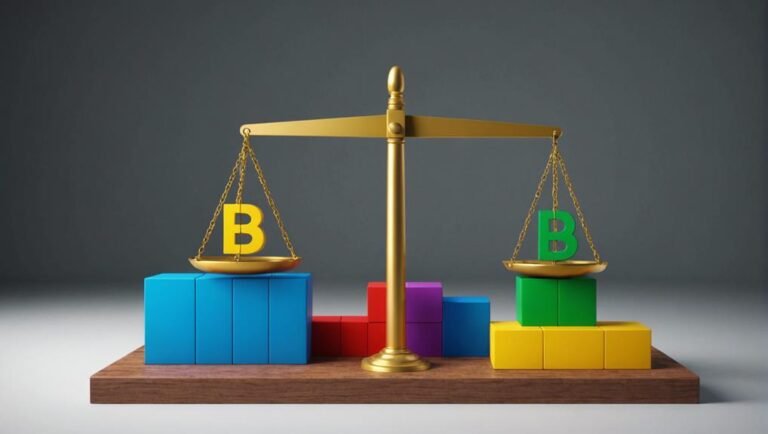U.S. Debt Ceiling: Definition, History, Pros, Cons, and Clashes
The U.S. Debt Ceiling, established in 1917, places a cap on government borrowing to uphold fiscal responsibility, control debt levels, and manage spending effectively. Adjustments to the ceiling through bipartisan compromises aim to balance government expenditures with revenue, ensuring financial stability. While it promotes fiscal discipline and accountability, some raise constitutional concerns and worry about its impact on debt costs and credit ratings. Debt ceiling clashes have reverberating global financial impacts, potential GDP reductions, and job losses. Recent developments highlight the importance of raising the ceiling to avoid defaults and maintain market stability, influencing economic growth and long-term budget decisions significantly.
Key Takeaways
- Debt ceiling sets borrowing limit to regulate government spending.
- Adjustments through bipartisan compromises ensure fiscal responsibility.
- Implementation fosters fiscal discipline and efficiency in bond issuance.
- Concerns arise over constitutional implications and market volatility.
- Clashes over debt ceiling can harm global financial stability and lead to economic downturns.
Establishment and Purpose of Debt Ceiling
Established in 1917, the debt ceiling in the United States serves as an important mechanism that sets a cap on the amount of money the government can borrow to fulfill its financial obligations. Originally intended to streamline government borrowing and expenditures, the debt ceiling aimed to prevent excessive reliance on borrowing to fund operations.
Over time, the debt ceiling has become a critical tool in regulating government spending and debt levels. By imposing limits on borrowing, the ceiling aims to guarantee fiscal responsibility and accountability in managing the nation's finances.
However, the necessity of raising the ceiling periodically reflects the increasing complexities of government finances and the challenges in balancing budgetary needs with fiscal constraints.
History of Debt Ceiling Adjustments
The evolution of debt ceiling adjustments in the United States showcases a dynamic interplay between fiscal policy demands and the necessity for financial flexibility.
- Bipartisan compromises have historically played a vital role in raising the debt ceiling.
- Adjustments have been made to uphold fiscal responsibility and avoid financial crises.
- Political negotiations and agreements have been indispensable in managing the complexities of debt ceiling adjustments.
These adjustments reflect the ongoing need for balance between government spending and revenue generation.
The history of debt ceiling adjustments highlights the challenges faced in maintaining the nation's financial stability while addressing the increasing debt levels.
Through strategic decision-making and bipartisan efforts, the U.S. has managed to navigate these challenges and ensure the continuity of essential government functions.
Advantages of Debt Ceiling Implementation
A structured debt ceiling mechanism fosters fiscal discipline and accountability in the U.S. financial system. By imposing limits on the amount of debt the government can accumulate, the debt ceiling promotes efficiency in bond issuance and guarantees that financial boundaries are established for monetary approval processes.
This framework compels policymakers to carefully consider the implications of borrowing, leading to more prudent financial decision-making. It acts as a safeguard against excessive spending, encouraging a more responsible approach to managing the country's finances.
Additionally, the debt ceiling serves as a tool to control government debt levels and prevent unchecked borrowing, ultimately contributing to the overall stability of the economy.
Drawbacks of Debt Ceiling Practices
Implemented at pivotal junctures in U.S. fiscal policy, the debt ceiling poses inherent drawbacks that warrant thoughtful consideration and strategic evaluation.
- Constitutional Concerns: Some experts argue that the process of raising the debt ceiling may conflict with the 14th Amendment, which states that the validity of the public debt shall not be questioned.
- Fiscal Responsibility: Critics raise concerns about the ease with which the debt ceiling is raised, potentially leading to irresponsible fiscal practices and lack of accountability in budgeting.
- Debt Costs and Credit Ratings: The uncertainty surrounding the debt ceiling can result in credit rating downgrades, increased debt costs, and market volatility, affecting the overall economic stability.
Impact of Debt Ceiling Clashes
Amidst political discord and economic uncertainty, debt ceiling clashes in the United States have reverberating impacts on global financial stability and the nation's economic trajectory.
The economic consequences of these clashes are profound, with the potential for default on debts leading to significant harm to the U.S. economy and global financial stability. Moody's Analytics predicts that a default could result in a 4% reduction in GDP and a loss of six million jobs, impacting not only the domestic market but also global economies.
Additionally, the political implications of these clashes are evident, as debates and negotiations over the debt ceiling can lead to downgrades in the U.S. credit rating, further complicating the fiscal landscape and hindering government functions.
Recent Debt Ceiling Developments
Recent developments surrounding the U.S. debt ceiling have underscored the ongoing challenges and complexities associated with managing the nation's financial obligations.
- Economic Implications:
- Failure to raise the debt ceiling could lead to a default, impacting the U.S. credit rating and potentially triggering a recession.
- Uncertainty surrounding the debt ceiling raises concerns among investors, affecting market stability and interest rates.
- The debt ceiling's impact on government borrowing costs can influence overall economic growth and fiscal health.
- Policy Implications:
- Political debates over the debt ceiling can disrupt budget planning and implementation of government programs.
- Delays or complications in raising the debt ceiling may necessitate emergency measures, affecting government operations and services.
- The debt ceiling serves as a tool to enforce fiscal discipline and shape long-term budgetary decisions.
Political Dynamics Surrounding Debt Ceiling
The ongoing political dynamics surrounding the U.S. debt ceiling illuminate the intricate interplay between fiscal policy decisions and partisan interests. Bipartisan negotiations and party disagreements often shape the discourse around raising the debt ceiling, showcasing the challenges of achieving consensus on vital fiscal matters. The table below further highlights the key factors influencing the political dynamics surrounding the debt ceiling.
| Factors Influencing Political Dynamics |
|---|
| Bipartisan Negotiations |
| Partisan Interests |
| Public Opinion |
| Economic Implications |
| Historical Precedents |
Conclusion
To sum up, the U.S. debt ceiling acts as a crucial safeguard against financial instability, similar to a sturdy dam protecting against flooding. While it promotes fiscal discipline and guarantees necessary funding, conflicts over its adjustment highlight political tensions.
As the national debt continues to rise, managing the complexities of the debt ceiling remains essential to maintaining economic stability and global credibility. Its history, advantages, drawbacks, and political dynamics all contribute to shaping the financial landscape of the United States.







